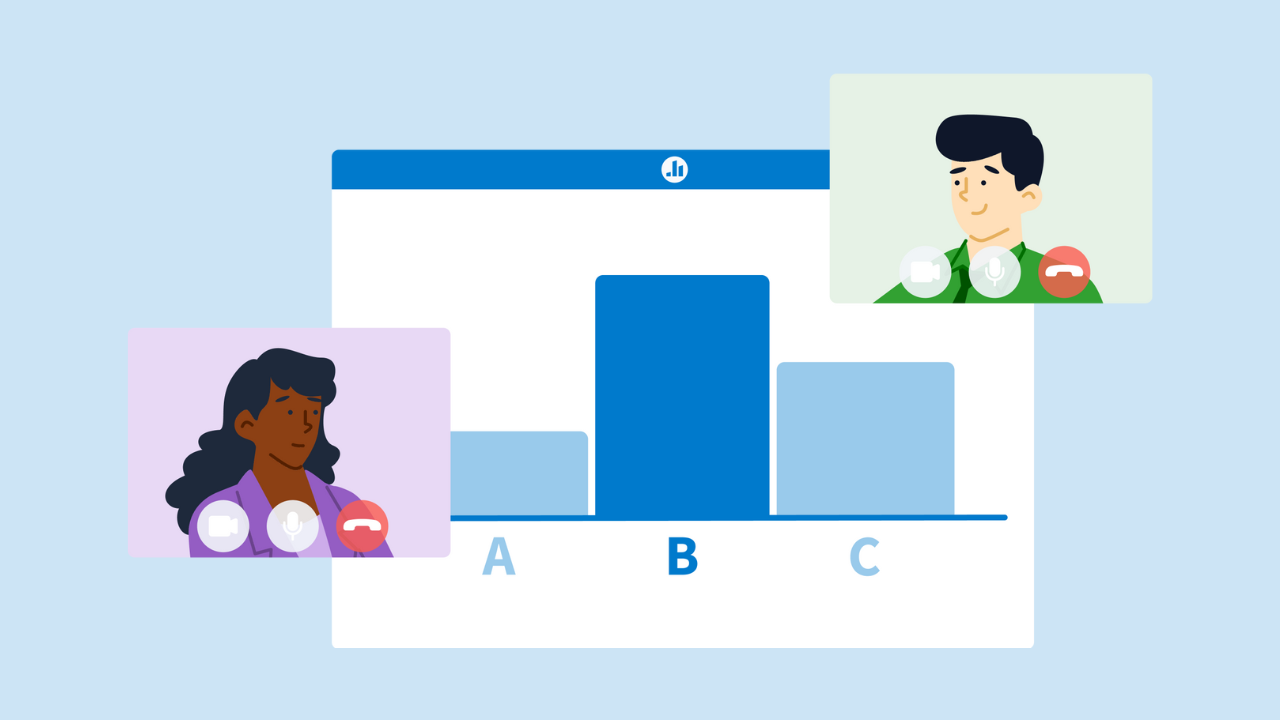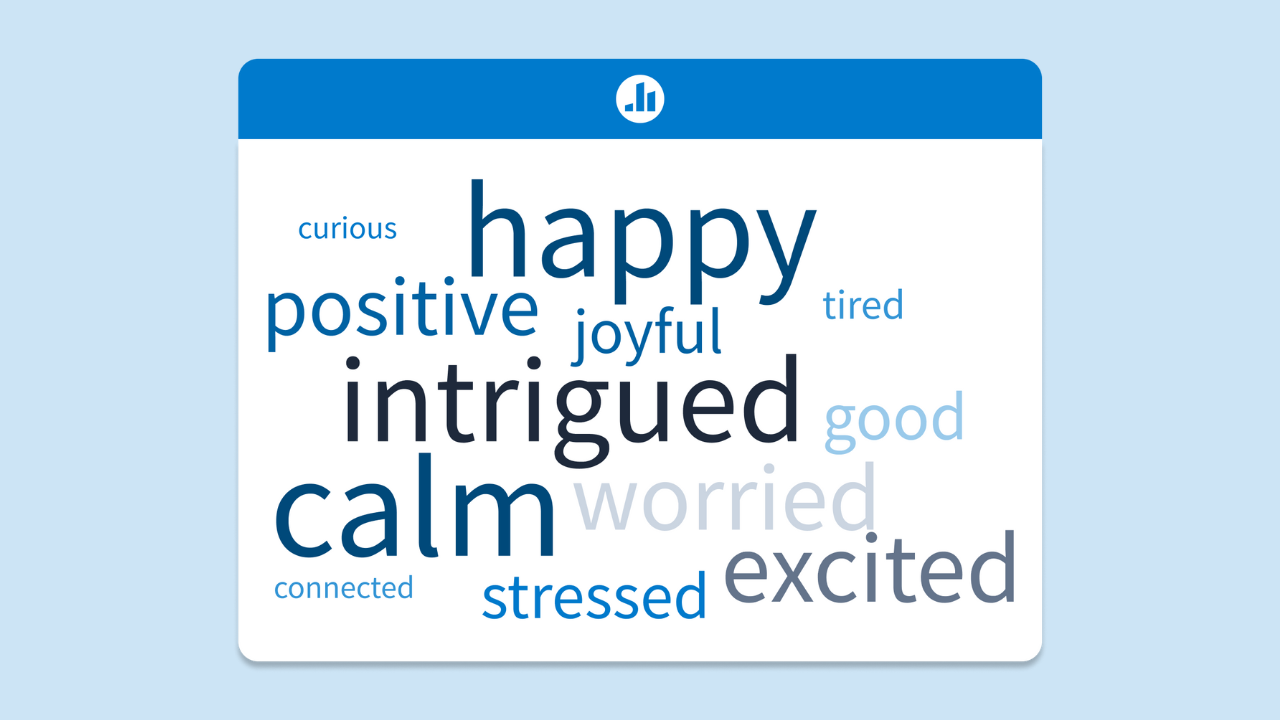Pulse Checks Made Easy: 30 Multiple-Choice Poll Questions for Work

Do your remote workers feel engaged? If your answer is “No” or even “I don’t know,” it’s time to check-in. Gallup found that only 38% of remote employees feel engaged at work and only 28% feel connected to their company’s purpose and mission—a record low not seen since 2011.
One way to gather valuable employee insights and spot disengagement trends is with multiple-choice polling tools. These tools help you gather feedback and also foster two-way communication while hosting virtual meetings.
Ready to increase remote employee engagement? We’ll show you how to craft thoughtful multiple-choice poll questions for work, share 30 examples, and introduce you to polling tools like Poll Everywhere so you can start gathering insights directly from your team.
How to craft effective multiple-choice poll questions for work
Before diving into polling question examples, let's explore three key principles for effective poll design:
3 key elements of good poll questions
1. Define what you want to achieve
What objective are you hoping to achieve with employee feedback? This may include assessing engagement, understanding whether workplace benefits are viewed as competitive, or even whether employees feel their managers are effective. A focused goal for your poll questions allows you to meet these objectives:
- Tailor questions for specific teams or projects.
- Simplify your poll by only including questions that are most vital to your goal.
- Benchmark responses to measure growth or success.
2. Balance simplicity and depth in options
Clearly worded and concise questions help employees understand what it is you’re asking and ensure your responses are accurate.
Additionally, keep multiple-choice answer options limited; use only enough to gather nuanced feedback. You might also consider adding an “Other” or “N/A” option for flexibility.
Bonus tip: Conducting a live poll? Get your audience warmed up with one of these funny icebreaker poll questions.
3. Avoid bias and priming
Structure your questions in a neutral way by avoiding leading language. This applies to answer options as well; respondents should see options that accurately reflect all possible answers.
If it makes sense, set up your polls to allow anonymous answers. For example, Poll Everywhere lets employees submit anonymous responses to more sensitive questions. This encourages honest feedback by removing fear of retribution or judgment.

30 best poll questions for gathering employee feedback
Employee satisfaction and company culture
Connection and engagement are major focuses when it comes to studies on the impact of remote work. And while only 17% of employees noted they don’t feel connected at work in Buffer’s 2023 State of Remote Work report, further comments by this small cohort highlight why it’s important to gauge employee engagement.
Of these disconnected employees, 56% said there’s no opportunity to connect socially at work, and 53% said they don’t interact with their colleagues. With that in mind, here are some example questions to help you keep tabs on employee engagement:
1. Do you feel recognized for your accomplishments at work?
a. Always
b. Often
c. Sometimes
d. Rarely
e. Never
2. Do you find your work meaningful?
a. Strongly agree
b. Agree
c. Neutral
d. Disagree
e. Strongly Disagree
3. Do you believe your opinions are valued at work?
a. Always
b. Often
c. Sometimes
d. Rarely
e. Never
4. How likely are you to recommend this company to a peer?
a. Very likely
b. Likely
c. Neutral
d. Unlikely
e. Very unlikely
5. How satisfied are you with your ability to engage with coworkers in a meaningful way?
a. Very satisfied
b. Satisfied
c. Neutral
d. Dissatisfied
e. Very dissatisfied
Team collaboration and communication
A 2021 study published in Nature Human Behavior journal found that remote work negatively impacted collaboration between employees, with colleagues spending about 25% less time collaborating compared to pre-pandemic collaboration. And while asynchronous communication can be a huge benefit of remote work, businesses must encourage and facilitate collaboration within and across teams.
Here are some sample questions to help you gauge whether employees feel empowered and able to collaborate:
6. Does your manager clearly communicate expectations?
a. Always
b. Often
c. Sometimes
d. Rarely
e. Never
7. Do you regularly receive constructive feedback from your manager?
a. Daily
b. Weekly
c. Monthly
d. Quarterly
e. Never
8. Are you comfortable providing feedback to your manager?
a. Very comfortable
b. Somewhat comfortable
c. Neutral
d. Uncomfortable
e. Very uncomfortable
9. Do you feel like a valued member of your team?
a. Strongly agree
b. Agree
c.Neutral
d. Disagree
e. Strongly Disagree
10. Do you feel like you can depend on other members of your team?
a. Always
b. Often
c. Sometimes
d. Rarely
e. Never
Management and leadership
You may have heard that employees quit because of bad managers. A study by Zenger/Folkman proved its truth, finding that poorly rated managers were more likely to have employees doing the bare minimum of necessary work and less likely to have employees who were willing to put in more effort.
Remote work can make it difficult to understand whether your managers and leaders are effective. This is why regular polling is essential for uncovering challenges before they result in the loss of valuable employees.
11. Does your manager clearly explain how your performance is measured?
a. For every project or task
b. For most projects or tasks
c. For some projects or tasks
d. Never
12. Do you agree that leadership keeps everyone informed?
a. Strongly agree
b. Agree
c.Neutral
d. Disagree
e. Strongly Disagree
13. Do you feel your manager provides adequate mentorship and coaching?
a. Strongly agree
b. Agree
c.Neutral
d. Disagree
e. Strongly Disagree
14. Do you feel like your supervisor is invested in your success?
a. Strongly agree
b. Agree
c.Neutral
d. Disagree
e. Strongly Disagree
15. Do you believe senior leadership demonstrates integrity?
a. Always
b. Often
c. Sometimes
d. Rarely
e. Never
Compensation and benefits
Staying on top of market trends and providing competitive pay and benefits helps companies attract and retain top-performing workers. For remote workers, there’s also the debate about whether pay should be based on location or simply on quality of work.
As for benefits, a recent Forbes Advisor poll found the top five benefits employees want are employer-covered healthcare, life insurance, retirement plans, mandatory PTO, and mental health assistance.
Clearly, there are many nuances to virtual employees’ compensation and benefits. To get the clearest picture of current sentiment, you need to ask direct questions:
16. Do you feel appropriately compensated for your job?
a. Strongly agree
b. Agree
c. Neutral
d. Disagree
e. Strongly Disagree
17. Do you agree that [company] provides competitive compensation and benefits?
a. Strongly agree
b. Agree
c. Neutral
d. Disagree
e. Strongly Disagree
18. Do you feel satisfied with the current health and dental insurance options?
a. Very satisfied
b. Satisfied
c. Neutral
d. Dissatisfied
e. Very dissatisfied
19. Do you have a clear understanding of compensation policies and available benefits?
a. Strongly agree
b. Agree
c. Neutral
d. Disagree
e. Strongly Disagree
20. Do you feel satisfied with the current PTO policy?
a. Very satisfied
b. Satisfied
c. Neutral
d. Dissatisfied
e. Very dissatisfied
Professional growth and development
Keeping good employees on your roster isn’t all about salary and benefits. The 2023 State of Performance Enablement Report by Betterworks found that 35% of employees were seeking a new job to pursue career advancement, while 34% were thinking of leaving for a new job to gain professional growth opportunities.
To assess whether your employees are satisfied with your growth and skills development opportunities, try asking these poll questions:
21. Do you believe there’s a clear path for career advancement here?
a. Strongly agree
b. Agree
c. Neutral
d. Disagree
e. Strongly Disagree
22. Do you feel there’s an opportunity to reach your full potential here?
a. Strongly agree
b. Agree
c. Neutral
d. Disagree
e. Strongly Disagree
23. Do you believe the benefits you receive are as good as the industry standard?
a. Strongly agree
b. Agree
c. Neutral
d. Disagree
e. Strongly Disagree
24. Are you satisfied with the available training and professional development resources?
a. Very satisfied
b. Satisfied
c. Neutral
d. Dissatisfied
e. Very dissatisfied
25. Do you feel there are sufficient coaching and mentorship opportunities here?
a. Strongly agree
b. Agree
c. Neutral
d. Disagree
e. Strongly Disagree
Work-life balance and employee well-being
One of the most commonly shared benefits of remote work is the ability of employees to balance their jobs with their personal lives. In 2023, Pew Research Center found that 71% of remote workers said working from home helped them balance their work and personal lives. This is especially impactful for parents of children under 18.
As for well-being, Gallup found that 44% of global employees experienced stressful workdays. Along with being detrimental to health as a whole, stress can negatively impact employee performance and productivity, making mental health initiatives a worthwhile investment for employers.
26. Are you satisfied with your work hours?
a. Very satisfied
b. Satisfied
c. Neutral
d. Dissatisfied
e. Very dissatisfied
27. Do you feel you have a healthy work-life balance?
a. Strongly agree
b. Agree
c. Neutral
d. Disagree
e. Strongly Disagree
28. Do you feel like management supports your work-life balance?
a. Strongly agree
b. Agree
c. Neutral
d. Disagree
e. Strongly Disagree
29. How often do you work overtime?
a. Never
b. Rarely
c. At least once a month
d. At least once a week
e. Daily
30. How often do you feel stressed or overwhelmed at work?
a. Never
b. Rarely
c. At least once a month
d. At least once a week
e. Daily
Bonus: Additional poll ideas to nurture employee engagement
Employee surveys don’t have to be all work and no play. Use icebreaker questions to help even the most introverted coworkers open up and share about their dream job, favorite color, or even best-loved Harry Potter character.
Additionally, funny poll questions can add a lighthearted vibe to your meeting or boost the energy level—a lifesaver for those early-morning meetings.
Fun poll questions
- Which ice cream flavor best represents you?
- Would you rather explore space or the ocean?
- If you could have any superpower, what would it be?
- Which TV show theme song would you choose to represent your life?
- If you had to listen to one song for the rest of your life, what would it be?
Icebreaker poll questions
- What are you grateful for today?
- What’s one country you’d love to visit?
- What’s the best book you’ve ever read?
- What’s the most useful item you’ve bought this year?
- If you could be fluent in another language instantly, which one would you choose?
Open-ended poll questions
- What motivates you to do your best at work?
- What’s one thing you’d change about your job?
- What can [company] do to improve transparency?
- What opportunities does your manager give you to share feedback?
- How could [company] improve our career development opportunities?
How to implement multiple-choice polls in the workplace
Live polling tools
Interactive polling tools allow you to capture employee feedback during live meetings. This is key, especially during company all-hands, monthly team meetings, and manager one-on-ones.
These employee feedback tools, like Poll Everywhere, allow employees to engage and respond without needing to speak up on Zoom or send asynchronous messages via Slack or email. Thanks to Poll Everywhere’s slideware integrations with Google Slides, PowerPoint, and Keynote, managers can easily add multiple-choice questions to their presentations.
Employees can quickly and easily respond on their cell phones or laptops, making the whole process of capturing live feedback easy and efficient. Additionally, because feedback is collected in real time, leadership can quickly adjust the conversation to address questions or resolve issues.
Timing and frequency of polls
Great Place to Work advises requesting employee feedback at least once a year, but it can be helpful to send out shorter “pulse” surveys—especially before, during, and after major changes.
The timing and frequency of your polls can affect whether employees take the time to share meaningful responses or not. Survey fatigue, or the loss of interest in responding to polls due to the frequency, number of questions, or even effort required to complete them, leads to lower response rates and reduced employee voice.
How to analyze poll results for actionable insights
Interpret responses and set benchmarks
Analyze your data based on the frequency of answer choices and look for trends, patterns, and areas that need improvement. Use this data to set benchmarks so you can measure the impact of employee engagement.
You can also segment your data to gain more granular insights. Different segmentations may include these details:
- Demographics
- Office location
- Level of seniority
- Team
Segmentation helps you understand the state of employee engagement in more detail. For example, you may see a good overall engagement score, but when you narrow results down to specific departments, you notice one or two have lower-than-average engagement.
Communicate results
Once surveys are completed, thank employees for participating and be transparent about when you’ll share results.
Remember, your workforce doesn’t know what happens behind the scenes when it comes to gathering and interpreting the data, so it’s helpful to communicate what they can expect and when.
It’s also important to share what actions the company plans to take—at least once you’ve solidified next steps. Open communication helps reduce frustration and the potential for employees to feel their feedback wasn’t heard.
Turn data into decisions
Once you’ve identified trends, benchmarks, and areas for improvement, work with your people teams to develop action plans based on poll responses. Empower each team to develop and implement action plans based on their specific needs and any relevant contexts.
Plan follow-up pulse surveys to measure the progress of action plans and seek additional feedback. Encourage teams to also openly discuss how they feel about progress. Here are a few ideas for pulse survey questions:
- Do you feel your team is improving in this area?
- What’s working well?
- What’s not working well?
- Do you have additional ideas for improvement?
3 examples of successful multiple-choice polls in action
1. Hyphn
As workspace solutions company Hyphn shifted its company-wide meetings from in-person to virtual, it needed a way to gather feedback from the audience in real time. Poll Everywhere provided a streamlined way to collect live feedback and analyze it later for valuable insights.
“It’s really challenging for presenters to understand if everyone is on the same page in a virtual environment, so Poll Everywhere gives us a good place to check in during the conversation and provides a much-needed break from continuously talking,” says Heather Leachman-Beck, Director of Workplace Innovation.
2. AdviCoach
Business coach Tom Hamp knows virtual employee training and meetings benefit from interactive presentations. While presenting virtual group sessions for AdviCoach, he uses Poll Everywhere to create two-way conversations by displaying anonymous responses while he presents.
“It’s really easy to get started because the controls are right there in your PowerPoint and you’re able to add activities directly into your presentations,” says Hamp.
3. JJR Solutions
Transparent communication is key, both from leadership and employees. Management consulting firm JJR Solutions announced an upcoming change for the company and used Poll Everywhere to gauge employee understanding and sentiment.
“In real time, people could share whether they’re aware of the change, whether they understand it, or whether they’re committed to it,” says Kara DeMusz, a marketing communications manager. “Then, at the end of the presentation, he ran the same question again to see if there were any differences.”
Encourage valuable employee feedback with Poll Everywhere
Thoughtfully crafted multiple-choice polls are a valuable tool for companies and teams to gauge employee engagement and gather feedback. These valuable insights help you spot ways to improve employee satisfaction, productivity, and success.
Once you ask employees to share their thoughts, be sure to communicate how their feedback will be used and follow through with data-driven decisions. After all, transparent, consistent communication helps employees feel valued.
Poll Everywhere's easy-to-use interface allows you to quickly craft a variety of multiple-choice questions for company-wide surveys, team-building exercises, and training assessments. Employees can easily submit responses via the Poll Everywhere mobile app or a browser, and you can display real-time feedback with charts, graphs, and Word Clouds. Additionally, employees can share anonymous feedback about company culture, management, or even job satisfaction.
Schedule a demo today to discover how Poll Everywhere helps you gather employee feedback.


